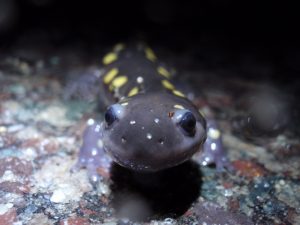Get Ready for Big Night!
Written by Michele Grzenda, Lincoln Conservation Director
Even though it is still winter, warmer days and increased daylight is upon us! With that brings my favorite event: Big Night!
“Big Night” is often used to describe the annual ritual of certain frogs and salamanders when they migrate from their upland overwintering habitat towards their spring breeding ground. During Big Night, you have a chance of seeing spotted salamanders, wood frogs, spring peepers, and other amphibians heading towards a vernal pool (generally a small pond or wetland which dries up in the summer months and does not support fish populations).
When will Big Night occur? It is always hard to predict as it generally happens on the first few rainy nights in March and early April when the night temperature is above 40 degrees. Most years, Lincoln does not have one “Big Night”, but rather lots of smaller movements (“Many Little Nights” doesn’t sound as exciting as “Big Night”). Even though the snow lingers in Lincoln, towns just south of here are already hearing frogs and seeing some salamander migration. With very warm temperatures predicted after March 8th and wet weather coming the weekend of the 12th, we are only days away from the excitement.
Big Night is bitter-sweet to many naturalists. It is fun to see the amphibians on the move, however, in a landscape bisected by a network of roads, it often means that these small creatures risk their own life crossing onto pavement each year. The best we can hope for is that Big Night happens late at night, when most cars are off the roads.
What you can do
Consider visiting a roadway on a rainy night looking for migrating salamanders. Lincoln Conservation Department has placed signage at three major salamander crossings – Conant Road, Lexington Road, and Silver Hill Road – warning motorists to drive carefully on rainy nights. There are some commonsense precautions you should take:
- Find a spot to park well before you reach the wetland crossing.
- Wear reflective vests or clothing if possible.
- Have multiple flashlights and be very careful looking where you walk – you don’t want to step on a frog and salamander!
- Keep young children next to you and show them how to look with a flashlight before walking.
- Assume vehicles do not see you and stay off the road when they approach.
- Wear warm, weather resistant clothing and shoes.
- Wash your hands after – if you handle the amphibians.
Amphibians do not like to be handled so in most cases simply observe them. If vehicle headlights are in the distance and there is a frog or salamander in the road, please move it off the road in the direction it is heading. Moisten hands if possible, in a puddle before handling it to minimize disturbance to their skin. You are likely to see (yellow) spotted salamanders (which can be 9” long), wood frogs, spring peepers, and American toads. And there is always a possibility of a rarer sighting, such as a blue-spotted salamander. Once you experience first-hand the activity on these special nights you will certainly understand the concern we have for these small creatures. On all rainy nights in spring and summer there is considerable activity on the roadways so please keep that in mind as you are out on any roadway. Be safe but try to give them a chance at survival.
To learn more about Amphibians, Vernal Pools, and Big Night, check out www.Vernalpool.org
Drivers: Be alert for frogs and salamanders on rainy nights this spring! This salamander may look huge in this picture, but they are small and camouflaged as they SLOWLY cross the many roads throughout Lincoln this spring.


